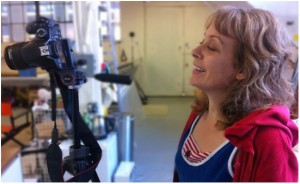I’ve sat on a few art juries before in a darkened room for hours looking at hundreds of projected images. The consensus from numerous jurors is that although you create outstanding art, if your images don’t show it, you can forget about getting selected.
Sometimes an overly dark or blurry photograph of a painting or sculpture is projected on the screen and you wonder “How could someone put such exquisite care into their art and not have noticed how poor these digital images are?”
It can happen to the best of us. Unless you are a photographer already, you may not have the skills or the eye yet to even know when your images are representing your work well.
Here’s something I’ve noticed: I spend so many hours, days, months with each piece of art I make that I often can’t “see” what my digital images really look like. Because I have such a deep relationship with the work, I see it as I visualize it in my head not as it’s appearing on the screen.
I’ve had to really train my eye over the years to be discerning as to whether my pictures are really representing the work. And, yes, it’s taken years.
Some suggestions:
1. If possible, sit down at your computer with your original art piece in your line of vision. Glance back and forth at both and pay attention to details, light, texture, etc. Really scrutinize every aspect of your work. Do those digital pictures really look like your work?
2. Find a discerning friend (or two) to do the same exercise. First show them the images on your computer, then show them the actual artwork. Ask them to be very specific as to the differences they see.
3. Invest in (or borrow) a good quality digital camera (a digital SLR with a detachable lens) to document your work. If you don’t have the funds yet, start putting away a little money each month. This will give you time to do your research.

4. Research your camera options fully before buying. Use the internet, consumer reports, your camera geek friends, youtube reviews, etc. Some camera buffs LOVE to talk about cameras and will be happy to share their knowledge with you. They’ll also throw around a lot of technical jargon that may confuse you. Take notes. Give yourself time to learn and study. Don’t rush into your purchase.
5. Make a list of all the features you need your camera to have. If you make jewelry, you’ll need a different type of lens from an artist who does large scale public artworks.
6. Save money. When you are sure of what you want or need and have the choices narrowed to a few models, keep an eye out for sales or scan craigslist.
7. Learn a photo editing program such as Adobe Photoshop. If you take your own photographs, you must learn to use Photoshop®. There are some easy-to-learn tricks for making your work look better on the computer screen which is where most people will see it first. Even if you aren’t a great photographer, don’t have the best camera or have less-than-ideal lighting there are tons of things you can easily correct if you know Photoshop®. I recommend Photoshop because it’s the industry standard, and once you learn the basics, you can take it further if you like.
8. If you do small scale, 2-D work, try scanning it. I’ve saved a lot of money on professional photography by scanning my small works on paper. Important because when you do a lot of drawing, you can be quite prolific.
9. Hire a professional! If all this sounds totally daunting, and you are in a position financially to hire a professional art documenter to photograph your work, please DO! It is one of the BEST investments you can make in your work. Keep in mind that not any professional photographer can do good art documentation. Just as not every painter knows how to do monotype. Different skill sets, different equipment. Do your research. Ask artist friends for recommendations or call local museums and galleries and find out who they use. Be prepared to spend at least $125 an hour or a per artwork fee, plus processing. You may be able to save money here if you know Photoshop and can do your own image processing.

Responses to “Nine Tips For Making Great Digital Images of Your Art”
Sharon Hauser
Good tips ~ thanks for sharing ~ Sherry
Julia Rymer Brucker
These are very helpful. I also find that if I take photos of my work in full, bright, early afternoon sun that the color is more accurate. Any other time of day and other lightwaves dominate– at noon the light contains the full spectrum. The big thing I struggle with is getting the picture straight, so I use a really good tripod as well.
admin
Yes! Julia – thanks for those tips – a tripod is essential. I also use a bubble level on my camera and on the work as the floor is often uneven.
Sue Sullivan
Great article, Michele!
radioshack wireless security cameras online australia
Studying your blog has given me a new perspective of the world. Thanks.